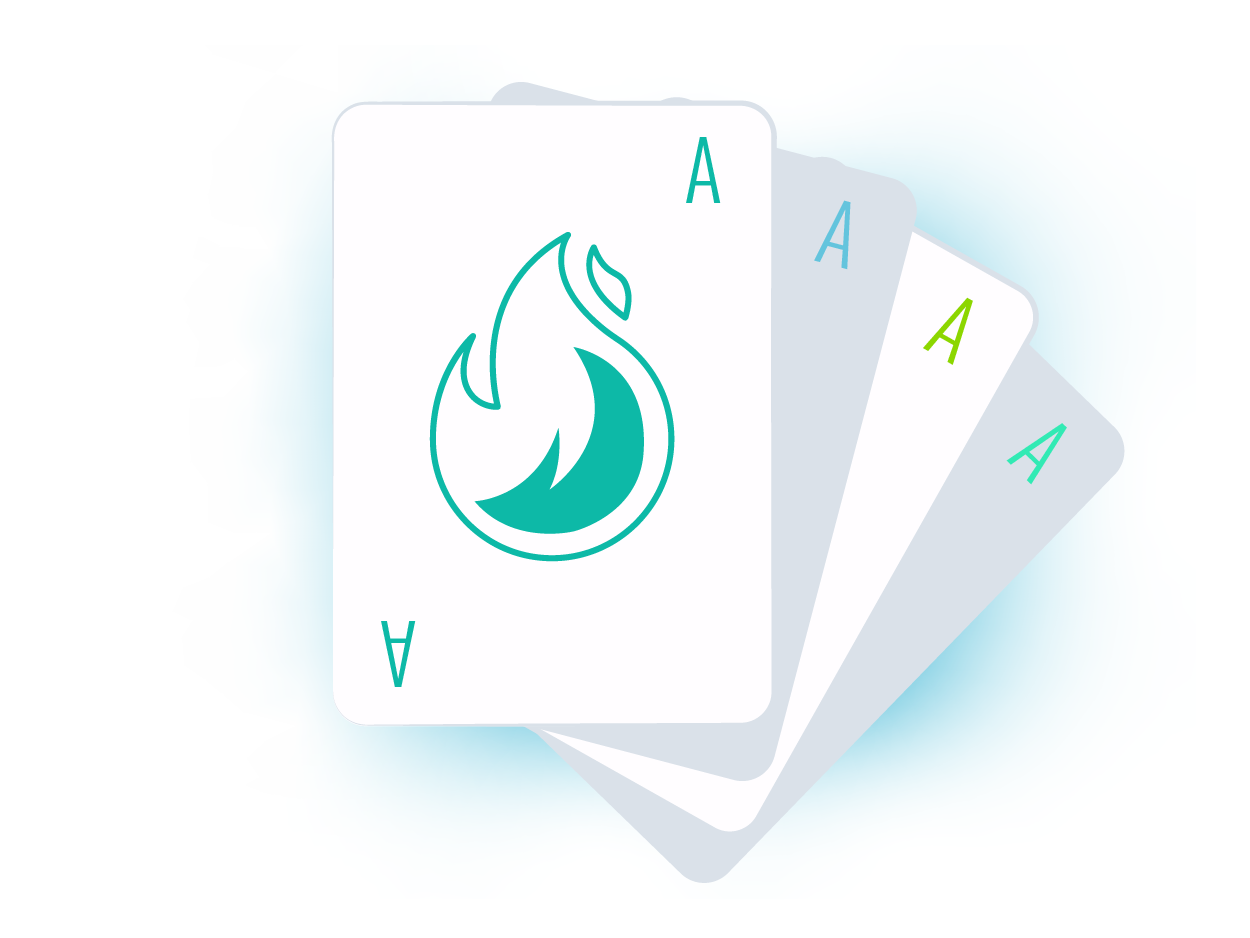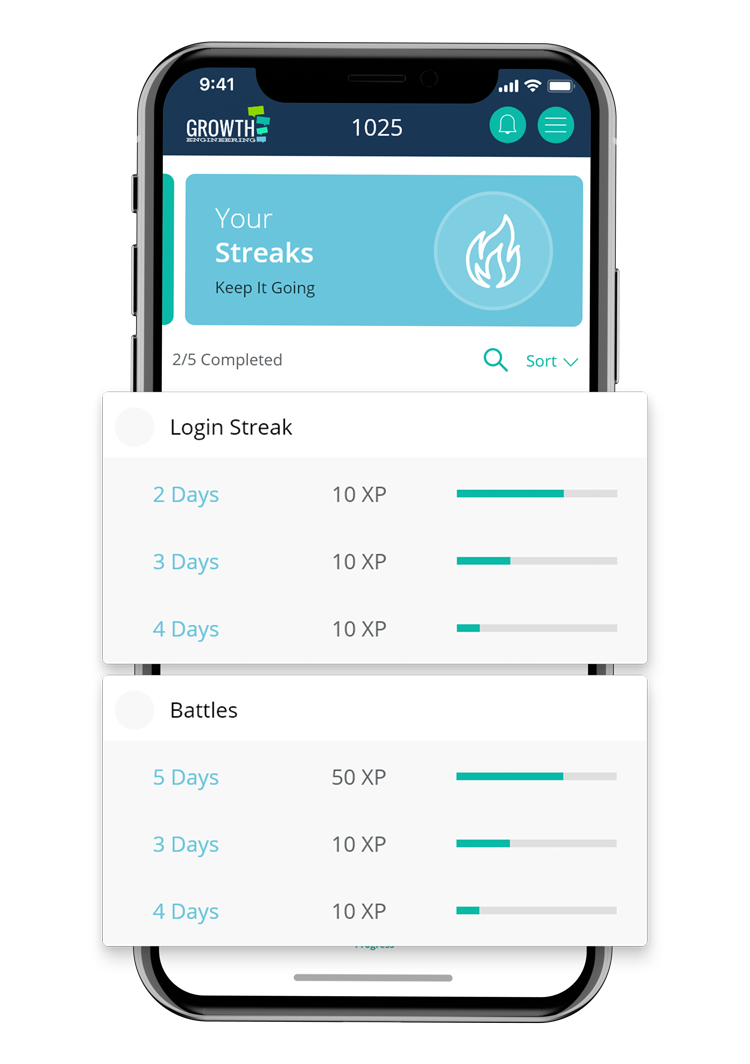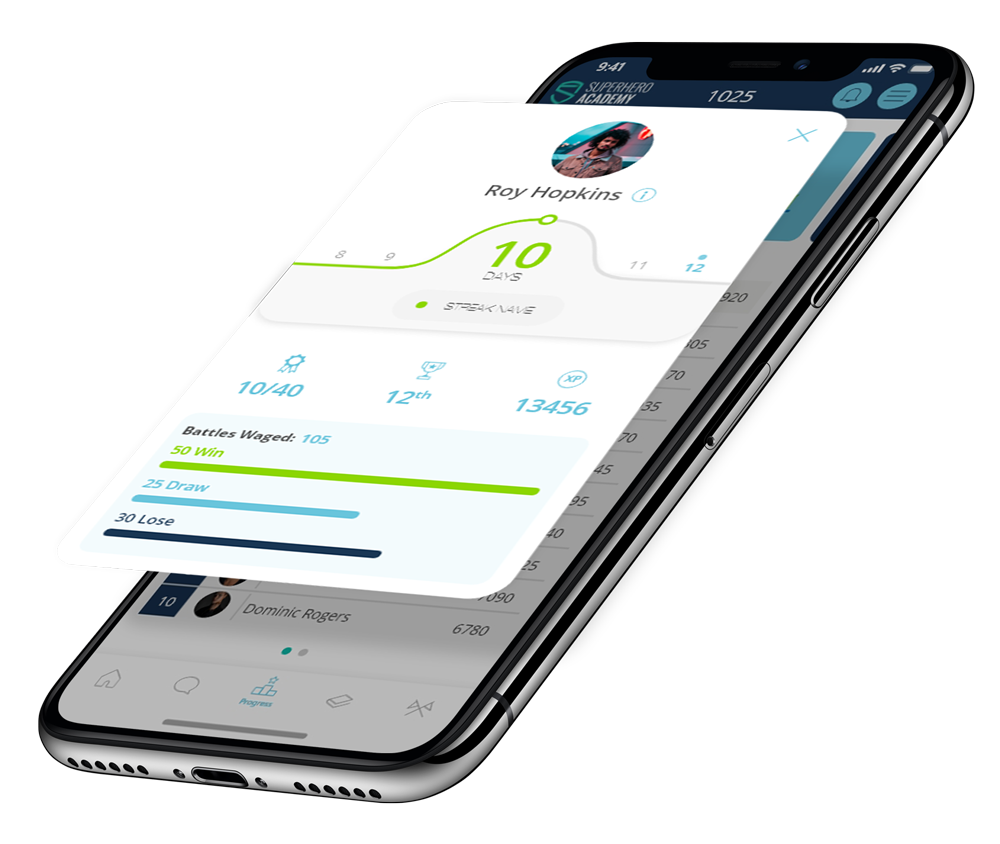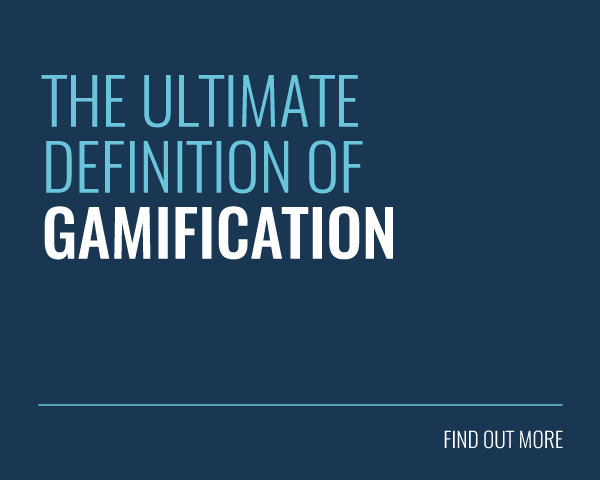 The pursuit of knowledge, self-improvement and skill development requires one thing: consistency. Streaks are a consistency cultivating tool. They’re yet another game mechanic that can be used to fuel better learning outcomes.
The pursuit of knowledge, self-improvement and skill development requires one thing: consistency. Streaks are a consistency cultivating tool. They’re yet another game mechanic that can be used to fuel better learning outcomes.
As one of the great philosophers of our time, Dwayne ‘The Rock’ Johnson, puts it: “Success isn’t always about ‘greatness’. It’s about consistency. Consistent hard work gains success.”
This principle has led to a lot of soul searching and research. We now know that it takes an average of 66 days to form a new habit. Furthermore, according to Malcolm Gladwell, mastery in any field requires 10,000 hours of deliberate practice.
Imagine a world where each day’s progress builds upon the last. This is the world streaks create. A world where you are propelled towards your goals with relentless momentum.
Over the course of this article we’ll explore what learning streaks are, how they work and why they’re so effective (spoiler alert: they have a solid foundation in behavioural psychology). We’ll also look at how they can be applied to your own learning environment.
Ready for your next hot streak? Then let’s get started!
What are Streaks?
Put simply, streaks are a consecutive series of actions or activities performed without interruption. They represent a commitment to consistency in pursuing a particular goal or habit over time.
This makes streaks a robust repetition mechanism. They reward you everytime you complete an action, meaning you’re more likely to keep doing it. This gives them an addictive quality.
In this respect, streaks are useful for establishing and maintaining a regular routine. This makes them easy to apply to areas like learning, exercise and productivity. For example, here are some targets you might set yourself:
- Learn a new word in a foreign language for 30 days straight
- Exercise for 40 minutes a day for 14 days straight
- Prepare a new dish every day for 10 days straight
- Quit smoking for six weeks.
Note that last example. Streaks can also be used to track abstinence or a lack of activity. Whatever your goal, streaks are useful because they provide a visual representation of your progress. This has been proven to ‘increase effort and commitment’.
Naturally enough, longer streaks are harder to maintain. But once a streak is broken, it’s broken. You’ll have to start again at the very beginning.
Streaks are typically tracked in your head, in calendars, journals or productivity apps. In some cases, they are ‘baked in’ to software solutions. This is true with apps like Duolingo, Candy Crush and the example below.
Snapchat Streaks

It’s hard to talk about streaks without mentioning Snapchat. This popular messaging app introduced streaks back in April 2015, leading to an explosion of activity.
Snapchat Streaks are a measure of your activity with another Snapchat user. A Snapstreak begins when you chat with somebody for three consecutive days. This is signified by a fire emoji (🔥) appearing alongside the user’s name in the chat log.
It’s easy to see how this habit-forming ritual could get addictive. Indeed, many young people use Snapstreaks to measure the strength of their friendships. According to Alphr, the current record holders are Samko and Fatmis with a score of 2,492.
What are Learning Streaks?
A learning streak occurs when an individual pursues a specific learning activity or goal over an unbroken sequence of days. It’s a commitment to consistent learning or skill development.
For instance, a musician might commit to playing an instrument every day for a set period, in order to improve their proficiency. Likewise, a programmer might set themselves daily coding challenges and a chess player may seek to solve a set number of puzzles per day.
Learning streaks can also be applied to the world of structured workplace learning, as we’ve done with Growth Engineering Learning App.
Why do Streaks Work?
Streaks are effective because they pull on a wide range of psychological levers and cognitive biases. They work because we crave consistency. But it goes a lot deeper than that. Here are some key aspects of behavioural psychology that inform the use of streaks:
Loss Aversion: Did you know that we’re more motivated by the fear of losing something than the prospect of gaining something of equal value? Put another way, it’s better not to lose £10 than it is to find £10. Breaking a streak means losing all your progress and having to start again from scratch. Now that’s a terrifying thought!
Consistency Bias: We have a natural tendency towards steadiness and stability. In fact, we have an ‘instinctual desire’ to remain consistent with our previous actions and beliefs. Nobody likes a flip-flopper. Streaks leverage this by encouraging regular activity, which helps us to form a consistent self-image.
Goal Gradient Effect: Clark Hull’s research back in 1932 found that the closer we get to achieving our goals, the harder we are willing to work. In other words, as you invest in your streaks, your commitment and activity will increase. After all, you won’t want to break your streak on day 9 out of 10!
Visual Progress: Streaks provide a visual representation of progress towards a goal. At any stage, you know exactly how close you are to your next achievement. It’s rare that goals are communicated to us in such a tangible and easy to understand manner. This can be a powerful motivator.
Increased Competence: As we maintain our streaks, we simultaneously build our competence and confidence. This increases our sense of belief and creates a rewarding feedback loop. It may even trigger the release of dopamine. This can help to motivate further activity.
With all these psychological factors at play, is it any wonder that streaks are so effective?
But the fun doesn’t have to stop there. Utilising streaks within group learning tasks can help to encourage social comparisons that fuel healthy competition.
Furthermore, asking your learners to publicly commit to their streaks creates cognitive dissonance if they fail to follow through. Indeed, research shows that public commitments are considerably more effective than private declarations.
How We Use Streaks
 We utilise streaks on Growth Engineering Learning App to help learners form healthy habits and track their progress. We currently have two types of streaks available.
We utilise streaks on Growth Engineering Learning App to help learners form healthy habits and track their progress. We currently have two types of streaks available.
- Login Streaks (for instance, logging in for 10 days in a row).
- Content Streaks (for instance, completing a piece of content 7 days in a row).
More streaks are on their way. Want to get started? If you have admin level access then setting up your streak couldn’t be easier:
- Give your streak a name (for instance, ‘10 Day Login Streak’).
- Add a description so that your learners know what the goal is.
- Add an eye catching image to inspire your learners into action.
- Select your streak type (‘Login Streak’ or ‘Content Streak’).
- And then select how many days your streak will run for.
- If you’d like, you can select an option to exclude weekends.
- Finally, select how much XP your learners will earn for completing their streak.
It’s that simple. If you know what you want to achieve then you can set your streak up in just a few minutes.
You can also set multiple streaks to run at the same time. For instance, why not have 2, 4, 6, 8 and 10 day content streaks for your learners to work towards?
Don’t Forget The Scorecard
 Our app solution also offers personalised learner Scorecards. This is a visual representation of the learner’s performance and progress within their learning environment. It’s yet another way to motivate your audience into action.
Our app solution also offers personalised learner Scorecards. This is a visual representation of the learner’s performance and progress within their learning environment. It’s yet another way to motivate your audience into action.
At the top of each Scorecard, in prime position, is the learner’s progress towards their current streak targets. This makes it easy to understand where they are in their learning journey. The Scorecard also contains:
- The learner’s Badge count
- The learner’s XP tally
- The learner’s Battle results
- The learner’s Microunit progress
Level Up Your Streaks
Streaks have been proven to be remarkably effective on their own. Just look at the lengths we go to to maintain our Snapstreaks, Duolingo Streaks and (back in the day) our Peloton Streaks.
Indeed, according to Duolingo, there are currently over 6 million people on a streak of 7 days or more. Wow! But there’s still further ways to make your streaks more effective.
Triggers & Reminders: For streaks to work, your learners need to know that they exist. Then they need to be motivated to take action. As such, always ensure you have an effective call to action in place. But don’t stop there. You’ll need a healthy flow of reminder notifications to help drive consistency and establish new learning routines.
Use Strong Visuals: Part of why streaks work is because they provide a clear visual representation of our progress towards a goal. If you support this with the right imagery and visual tracking devices then you’re sure to fire your learners up. They’ll know exactly where they stand and how far away they are from their overall objective.
Make it Social: As we’ve explored, streaks can be remarkably effective within a social context. After all, we all seek out validation from our peers. We feel a sense of commitment towards the communities that we are a part of. Streaks help to create social accountability, driven by our desire not to disappoint others.
Offer Tangible Rewards: Streaks themselves, offer us a form of intrinsic motivation. We’re motivated to maintain our streaks so that we can preserve our positive self-image. But you may also consider offering extrinsic rewards in return for streak achievements. For instance, Duolingo offers access to an exclusive ‘Streak Society’ for those with 50+ day streaks.
The Challenges with Streaks
 As we’ve seen, streaks are powerful motivators and great habit-forming tools. However, they can cause issues when they are misassigned or overemphasised. As such, we’d be remiss if we didn’t mention some of the ethical concerns linked to streaks.
As we’ve seen, streaks are powerful motivators and great habit-forming tools. However, they can cause issues when they are misassigned or overemphasised. As such, we’d be remiss if we didn’t mention some of the ethical concerns linked to streaks.
For instance, streaks can lead to obsessive behaviour. Utilising such a psychologically effective tool can lead to a deluge of enthusiasm that may spill over into fixation or compulsion. This, in turn, can lead to unnecessary stress and anxiety.
Consider, for instance, the runner who continues to train despite having picked up an injury. Or the obsessive drummer who practises for hours a day, at the expense of relationships with his family and friends (Whiplash — great movie!).
There’s also the crushing psychological impact of breaking a streak. Research shows that this can be highly demotivating. It can even lead to people avoiding the associated behaviour in the future.
With this in mind, you should apply streaks responsibly to your learning environment. You should always consider your learners’ well-being and the overall sustainability of your learning programme.
There’s a reason why Netflix doesn’t tell you that you’re on a 10-hour binge streak. Likewise, you won’t proudly display a punch card showing that you’ve eaten Mars bars for ten days in a row.
As NYU professor Adam Alter puts it, ‘streaks are morally neutral’. It’s how you apply them that makes all the difference.
Learning Streaks: Final Words
There we have it. Our streak has finally come to an end.
We now know that streaks are effective because they are rooted in human psychology and the way our brain operates. Every journey starts with just a single step. But streaks help us to visualise the entire journey and plot our progress along the way.
This helps us to build momentum, maintain motivation and stay consistent in the pursuit of our goals. Before long, your learners will start to form new habits and change their behaviour. This can lead to better learning outcomes and genuine business impact.
As such, if you apply your learning streaks in the right way, then success is sure to follow. The pathway to continuous improvement awaits!
Thank you for reading. Would you like to learn more about other game mechanics, such as Badges, XP, Levels and Leaderboards? Then download ‘The Ultimate Guide to Gamification in Online Learning’.








